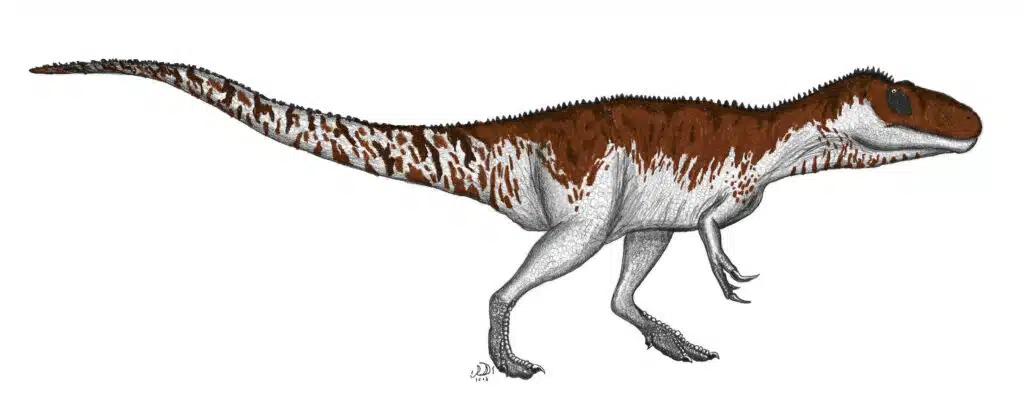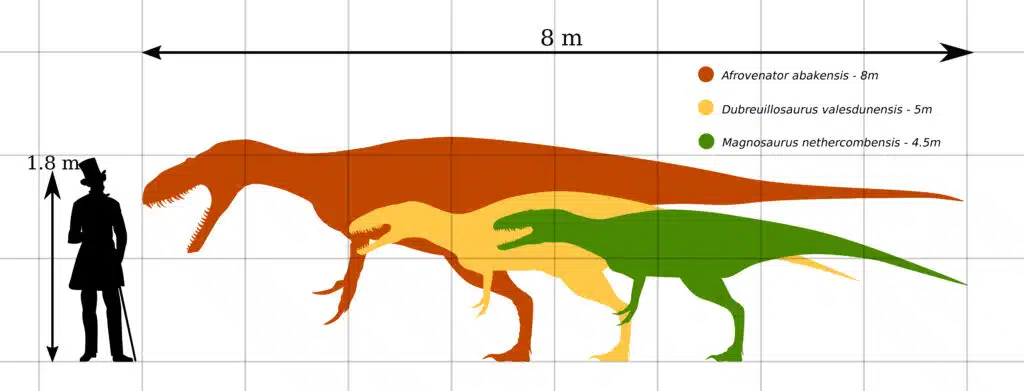Afrovenator, whose name fittingly translates to ‘African hunter’, was a formidable predator . It roamed the landscapes of what is now Niger, in Africa during the Middle Jurassic period.
The Afrovenator’s story is one of discovery and ongoing scientific inquiry. Unearthed in 1993, this dinosaur has since offered invaluable insights into the rich biodiversity of the Jurassic period. Its nearly complete skeleton, a rarity among theropods, has allowed us to piece together a detailed picture of its anatomy and lifestyle. As we delve into the world of this dinosaur, we’ll explore its origins, unique features, and the environment it called home.
Afrovenator Key Facts
| Keyword | Fact |
|---|---|
| Afrovenator pronunciation | af-ro-vee-nay-tor |
| Meaning of Name | African Hunter |
| Group | Theropod |
| Type Species | Afrovenator abakensis |
| Diet | Carnivore |
| When it Lived | 170.3 to 145.0 MYA |
| Period & Time | Middle Jurassic |
| Epoch | Bajocian to Late Jurassic |
| Length | 22.0 to 26.0 ft |
| Height | 8.0 ft at hip |
| Weight | 1.0 ton |
| Mobility | Moved on two legs |
| First Discovery | 1993 by Paul Sereno, with Jeffrey Wilson, Hans Larsson, Didier Dutheil and Hans-Dieter Sues |
| Location of First Find | Agadez, Niger |
| First Described | 1994 by Paul Sereno, with Jeffrey Wilson, Hans Larsson, Didier Dutheil and Hans-Dieter Sues |
| Holotype | UC OBA 1 |
Afrovenator Taxonomy and Timeline
The first impression of Afrovenator begins with a name that evokes images of a formidable predator stalking the ancient landscapes of Africa. The name is derived from Latin roots, with ‘afer’ meaning ‘African’ and ‘venator’ translating to ‘hunter’. This dinosaur truly lived up to its name as a carnivorous theropod that was likely at the top of the food chain in its environment.

Belonging to the Megalosauridae family, the Afrovenator is part of the larger Theropoda group. The only known species of this genus is the Afrovenator abakensis, a testament to the uniqueness of this dinosaur.
The timeline begins in the Middle Jurassic period, specifically from the Bajocian epoch, and extends to the Late Jurassic, some 170.3 to 145 million years ago. This was a time of significant evolutionary diversification among dinosaurs and Afrovenator was a part of this vibrant era.
The first discovery was made in 1993 in Agadez, Niger, by a team led by the American paleontologist Paul Sereno. The team also included Jeffrey Wilson, Hans Larsson, Didier Dutheil, and Hans-Dieter Sues. The dinosaur was subsequently described by the same team in 1994, marking a significant contribution to our understanding of the dinosaur fauna of the Jurassic period.
Listen to Pronunciation
Fossil Evidence
The discovery in 1993, made in the Agadez region of Niger, is known for the relatively complete skeleton that was unearthed. This included parts of the skull, spinal column, forelimbs, a partial pelvis, and most of the hind limbs. The absence of the top of the skull and the lower jaws, apart from the prearticular bone, left some gaps in our understanding but the overall preservation of the skeleton was remarkable.

Subsequent finds have added to our knowledge of this dinosaur. Three additional discoveries in the Jurassic period deposits of Niger have provided further insights into it. These finds have helped to paint a more complete picture of its life and behavior.
Afrovenator Size and Description
This was a theropod dinosaur, a group characterized by their bipedal stance and carnivorous diet. Its body was built for speed, with a particularly long humerus that would have given the Afrovenator more reach. This dinosaur was lightweight and agile and likely relied on its speed and agility to hunt its prey.
Size and Weight of Type Species
Estimates of the size vary, but it is generally believed to have been about 22-26 feet long, and 8 feet high at the hip. Weight estimates are around 1 ton. These estimates are based on the nearly complete skeleton found in Niger, which includes most of the skull, spinal column, forelimbs, a partial pelvis, and most of the hind limbs. This size and weight would have made this carnivorous dinosaur a formidable predator in its environment.

The Ultimate Dino Quiz
Do you want to test your knowledge of dinosaurs? Then try this Ultimate Dino Quiz! Don’t worry if you get some of the answers wrong, and look at it as an opportunity to refresh and improve your knowledge!
Don’t forget to try our other games as well!
The Dinosaur in Detail
Afrovenator had several unique features, such as its long humerus and lightweight build, that suggest a dinosaur that was built for speed. These would have been influential adaptations for a carnivorous dinosaur, allowing it to chase down prey in its environment.
One of the most notable specimens is the nearly complete skeleton found in Niger. This specimen has provided invaluable insights into Afrovenator’s anatomy and lifestyle. For example, the skeleton shows that Afrovenator had a particularly long humerus, or upper arm bone, which would have given it a greater reach. This could have been a crucial advantage when hunting prey.
The skull was rather flat with a small maxillary fenestra and a distinctive rounded horn on top of the lacrimal bone near the eyes. The lower branch of the postorbital bone behind the eyes was transversely wide and the jugal bone near the cheek was short, deep, and pneumatized–meaning it was filled with air cavities. These features suggest a dinosaur with a keen sense of sight and possibly a complex social or mating behavior.
Afrovenator in its Natural Habitat
This dinosaur lived during the Middle Jurassic period, a time of significant evolutionary diversification among dinosaurs. The African environment it inhabited was likely diverse and dynamic, offering a range of opportunities and challenges for this dinosaur.
As a carnivore, Afrovenator would have been at the top of the food chain in its environment. Its diet likely consisted of smaller dinosaurs and possibly other animals. Given its body type, agility and speed would have made it a successful predator that could outrun its prey.
Its social behavior is less clear, but given its size and the nature of its environment, it’s possible that it was a solitary hunter. However, this is purely speculative, and more research is needed to confirm this.
Interesting Points about Afrovenator
- This is one of the most complete theropod dinosaurs discovered in Africa, a region where harsh environmental conditions can quickly erode exposed fossils.
- The long humerus is a distinctive feature, suggesting that it had a greater arm reach than other theropods of its time.
- Despite being a formidable predator, it was a lightweight dinosaur, built more for speed than brute strength.
- The skull had a distinctive rounded horn on top of the lacrimal bone, suggesting possible complex social or mating behaviors.
- The Afrovenator’s taxonomic history has been muddled, with it being described as a relative of various dinosaurs including Spinosaurus, Eustreptospondylus, Dubreuillosaurus, Megalosaurus, and even Allosaurus.
Contemporary Dinosaurs
One among many African dinosaurs, Afrovenator shared its world with a number of contemporaries.
One was Jobaria, a dinosaur that was significantly larger than Afrovenator. This size difference could have led to an interesting dynamic between the two. Afrovenator was smaller and likely faster and more agile, potentially giving it an advantage when it came to securing food or evading threats. On the other hand, Jobaria’s towering height and massive size would not have made for easy prey, even for Afrovenator.
Then there were Carcharodontosaurus and Spinosaurus, two carnivorous dinosaurs that were also larger than Afrovenator. Carcharodontosaurus–known for its sharp, serrated teeth–and Spinosaurus–with its distinctive sail-like spine–would have added another layer of complexity to Afrovenator’s environment.
These dinosaurs could have interacted with Afrovenator in a variety of ways, competing for the same prey. Through these interactions, they would have played a crucial role in shaping its behavior and lifestyle, contributing to the rich tapestry of life in the prehistoric world.
Sources
- https://www.sciencedirect.com/science/article/abs/pii/S0031018208005919
- https://paleobiodb.org/classic/basicTaxonInfo?taxon_no=56398
- https://www.personal.umich.edu/~wilsonja/JAW/Publications_files/Sereno&al1994.pdf
- https://go.gale.com/ps/i.do?p=AONE&u=googlescholar&id=GALE|A15855383&v=2.1&it=r&sid=AONE&asid=5cbc3a66
“Please note that the information in this article is based on various sources, drawing on scientific research, fossil evidence, and expert analysis. We work to provide a comprehensive and accurate overview of the dinosaurs. However, please be aware that our understanding of dinosaurs and their world is constantly evolving as new discoveries are made.”
Article last fact checked: Joey Arboleda,06-09-2023
Featured Image Credit: PaleoEquii, CC BY-SA 4.0, via Wikimedia Commons
